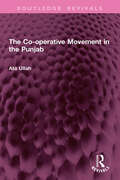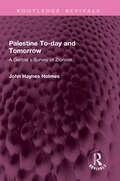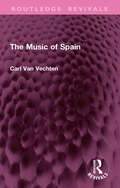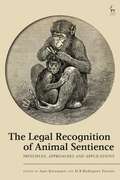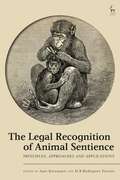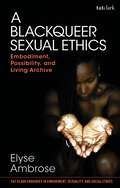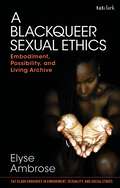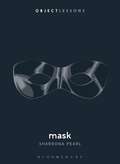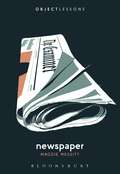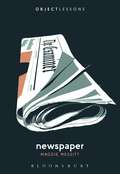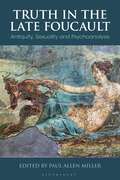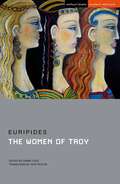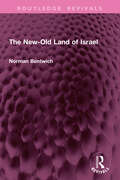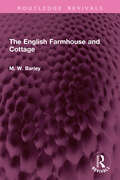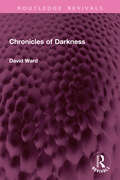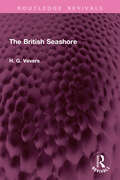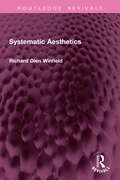- Table View
- List View
The Co-operative Movement in the Punjab (Routledge Revivals)
by Ata UllahFirst published in 1937, The Co-operative Movement in the Punjab presents a sketch of the development and working of the co-operative movement in the region in its various aspects. With its vast and fertile fields, it's sturdy and assimilative manpower, it's beautiful rivers and its marvelous canal system, the Punjab, the sword-arm of the erstwhile Empire, was the stronghold of co-operation in India. The book discusses various themes like agricultural indebtedness and aspects of rural credits; co-operation in India; agricultural credit societies; provincial co-operative bank; women and co-operation; milk recording societies; central banks; cattle insurance; stock breeding societies and land mortgage banks in the Punjab. This book is an important historical reference work for scholars and researchers of Indian history, agricultural history, South Asian history, history of Punjab, and history in general.
Palestine To-day and Tomorrow: A Gentile's Survey of Zionism (Routledge Revivals)
by John HolmesFirst published in 1930, Palestine To-day and Tomorrow provides a comprehensive overview of John Haynes Holmes’s experiences in Palestine. Chapter one is a running account, written on the spot, of his experiences in Palestine. Chapter two presents a brief statement of the facts and forces in Jewish history culminating in Zionism, is intended primarily for readers who may not be familiar with them. Chapter three is intended to be a careful and rather elaborate presentation of the difficulties and dangers which beset the path of Zionism in Palestine. Chapter four is an account of what has been done by the Jews in Palestine during a period of fifty years. And finally chapter five, in many ways the most important in the book is a discussion of the ideas and ideals of Zionism as these have appeared again and again in author’s presentation of the more practical aspects of the movement. This book is an important historical reference work to understand the history of the Arab - Jewish situation and the question of the English mandate.
The Music of Spain (Routledge Revivals)
by Carl Van VechtenFirst published in 1920, The Music of Spain deals with historical periods, schools and style and appears to embrace everything related to music provided it affects or is affected by Spain in some degree, no matter how small or insignificant. The period extends from the sixteenth century to the early twentieth century and the author encircles his subject in a huge ring or parenthesis that opens with Antonio Cabezon, the Spanish Bach (according to Pedrell) and closes with the gypsy dancer and singer Pastora Imperio, queen of the Spanish “varieties” stage of today. It brings themes like Spain and music; the land of joy; and from George Borrow to Mary Garden. This book is an important historical reference for students and scholars of history of music, Spanish music.
The Legal Recognition of Animal Sentience: Principles, Approaches and Applications
This book explores the movement towards the recognition of animal sentience in the law. It explores some first principles underpinning the recognition of animal sentience, including the nature and scope of sentience provisions, the connection between sentience and empathy, drafting issues, and the relationship between sentience recognition and animal rights. The book highlights the operation of animal sentience provisions in several jurisdictions throughout the world and considers some sector-specific applications and limitations of animal sentience recognition.The first book of its kind, it draws together different perspectives as to what this novel turn in the law might mean and where it might lead. The chapters provide a full picture of what the recognition of animal sentience might entail for humans, animals, and our environment, as well as the experiences of different legal jurisdictions in pursuing recognition of animal sentience.This collection is an essential read for both practitioners and academics alike, as well as any group seeking to advance the interests of non-human animals.
The Legal Recognition of Animal Sentience: Principles, Approaches and Applications
by Jane Kotzmann and MB Rodriguez FerrereThis book explores the movement towards the recognition of animal sentience in the law. It explores some first principles underpinning the recognition of animal sentience, including the nature and scope of sentience provisions, the connection between sentience and empathy, drafting issues, and the relationship between sentience recognition and animal rights. The book highlights the operation of animal sentience provisions in several jurisdictions throughout the world and considers some sector-specific applications and limitations of animal sentience recognition.The first book of its kind, it draws together different perspectives as to what this novel turn in the law might mean and where it might lead. The chapters provide a full picture of what the recognition of animal sentience might entail for humans, animals, and our environment, as well as the experiences of different legal jurisdictions in pursuing recognition of animal sentience.This collection is an essential read for both practitioners and academics alike, as well as any group seeking to advance the interests of non-human animals.
A Blackqueer Sexual Ethics: Embodiment, Possibility, and Living Archive (T&T Clark Enquiries in Embodiment, Sexuality, and Social Ethics)
by Professor Elyse AmbroseIn A Blackqueer Sexual Ethics: Embodiment, Possibility, and Living Archive Elyse Ambrose looks to an archive of blackqueerness as an authoritative source for religious ethical reflection. This approach counters the disintegrative norms of anti-black and anti-body traditionalism in Christian sexual ethics, even those that strive to be liberative. It builds upon a tradition of black queer and LGBTQ+-centered critique at the intersections of race, sexuality, gender, and religion through exploring the moral imagination of sexual and gender non-conformist communities in 1920's Harlem (their rent parties, blues environments, and Hamilton Lodge Ball); ethics and theology blackqueering the disciplines; and contemporary oral histories (including photographs of the subjects by the scholar-artist) of those doing ethics in their blackqueerness. These serve as integrative sites that signal blackqueer ethical counter-patterns of communal belonging, individual and collective becoming, goodness, embodied spirit/inspirited bodies, and shared thriving. Emphases on both personal and social right-relatedness mark a shift from Christian sexual ethics based on rules, toward a communal relations-based transreligious ethics of sexuality.
A Blackqueer Sexual Ethics: Embodiment, Possibility, and Living Archive (T&T Clark Enquiries in Embodiment, Sexuality, and Social Ethics)
by Professor Elyse AmbroseIn A Blackqueer Sexual Ethics: Embodiment, Possibility, and Living Archive Elyse Ambrose looks to an archive of blackqueerness as an authoritative source for religious ethical reflection. This approach counters the disintegrative norms of anti-black and anti-body traditionalism in Christian sexual ethics, even those that strive to be liberative. It builds upon a tradition of black queer and LGBTQ+-centered critique at the intersections of race, sexuality, gender, and religion through exploring the moral imagination of sexual and gender non-conformist communities in 1920's Harlem (their rent parties, blues environments, and Hamilton Lodge Ball); ethics and theology blackqueering the disciplines; and contemporary oral histories (including photographs of the subjects by the scholar-artist) of those doing ethics in their blackqueerness. These serve as integrative sites that signal blackqueer ethical counter-patterns of communal belonging, individual and collective becoming, goodness, embodied spirit/inspirited bodies, and shared thriving. Emphases on both personal and social right-relatedness mark a shift from Christian sexual ethics based on rules, toward a communal relations-based transreligious ethics of sexuality.
Mask (Object Lessons)
by Dr. Sharrona PearlObject Lessons is a series of short, beautifully designed books about the hidden lives of ordinary things.From the theater mask and masquerade to the masked criminal and the rise of facial recognition software, masks have long performed as an instrument for the protection and concealment of identity. Even as they conceal and protect, masks – as faces – are an extension of the self. At the same time, they are a part of material culture: what are masks made of? What traces do they leave behind? Acknowledging that that mask-wearing has become increasingly weaponized and politicized, Sharrona Pearl looks at the politics of the mask, exploring how identity itself is read on this object.By exploring who we do (and do not) seek to protect through different forms of masking, Sharrona Pearl's long history of masks helps us to better understand what it is we value. Object Lessons is published in partnership with an essay series in The Atlantic.
Newspaper (Object Lessons)
by Dr. Maggie MessittObject Lessons is a series of short, beautifully designed books about the hidden lives of ordinary things.Newspaper is about more than news printed on paper. It brings us inside our best and worst selves, from censorship and the intentional destruction of historic record, to partisan and white supremacist campaigns, to the story of an instrument that has been central to democracy and to holding the powerful to account. This is a 400-year history of a nearly-endangered object as seen by journalist Maggie Messitt in the two democratic nations she calls home – the United States and South Africa.The “first draft of history,” newspapers figure prominently through each movement and period of unrest in both nations-from the first colonial papers published by slave traders and an advocate for press freedom to those published on id cards, wallpaper, and folio sheets during civil wars. Offices were set on fire. Presses were pushed into bodies of water. Editors were run out of town. And journalists were arrested.Newspaper reflects on a tool that has been used to push down and to rise up, and a journey alongside the hidden lives that have harnessed its power.Object Lessons is published in partnership with an essay series in The Atlantic.
Mask (Object Lessons)
by Dr. Sharrona PearlObject Lessons is a series of short, beautifully designed books about the hidden lives of ordinary things.From the theater mask and masquerade to the masked criminal and the rise of facial recognition software, masks have long performed as an instrument for the protection and concealment of identity. Even as they conceal and protect, masks – as faces – are an extension of the self. At the same time, they are a part of material culture: what are masks made of? What traces do they leave behind? Acknowledging that that mask-wearing has become increasingly weaponized and politicized, Sharrona Pearl looks at the politics of the mask, exploring how identity itself is read on this object.By exploring who we do (and do not) seek to protect through different forms of masking, Sharrona Pearl's long history of masks helps us to better understand what it is we value. Object Lessons is published in partnership with an essay series in The Atlantic.
Newspaper (Object Lessons)
by Dr. Maggie MessittObject Lessons is a series of short, beautifully designed books about the hidden lives of ordinary things.Newspaper is about more than news printed on paper. It brings us inside our best and worst selves, from censorship and the intentional destruction of historic record, to partisan and white supremacist campaigns, to the story of an instrument that has been central to democracy and to holding the powerful to account. This is a 400-year history of a nearly-endangered object as seen by journalist Maggie Messitt in the two democratic nations she calls home – the United States and South Africa.The “first draft of history,” newspapers figure prominently through each movement and period of unrest in both nations-from the first colonial papers published by slave traders and an advocate for press freedom to those published on id cards, wallpaper, and folio sheets during civil wars. Offices were set on fire. Presses were pushed into bodies of water. Editors were run out of town. And journalists were arrested.Newspaper reflects on a tool that has been used to push down and to rise up, and a journey alongside the hidden lives that have harnessed its power.Object Lessons is published in partnership with an essay series in The Atlantic.
Truth in the Late Foucault: Antiquity, Sexuality, and Psychoanalysis (Bloomsbury Studies in Classical Reception)
The first full treatment of truth as a core philosophical concept in the late Foucault, this volume examines his work on the ancient world and the early church. Each essay features a deep examination as to how the topics of truth and sexuality intersect with and focus on Foucault's engagement with ancient philosophy and thought. Truth in the Late Foucault offers readings on Plato, Artemidorus, Cicero, Sophocles and the Stoics, and pays close attention to Cassian, Paulinus of Nola, and early Christian practices of confession. With the publication of the long-awaited volume 4 of the History of Sexuality: Confessions of the Flesh, the shape of the final Foucault is now brought into stark relief. As well as looking at ancient thought, the contributors explore Foucault's work in relation to philosophers such as Gadamer, Heidegger, Derrida and Descartes. Foucault's long-running and often contentious dialogue with psychoanalysis, on the relation between truth and the subject, is also examined. Each essay not only makes an important statement, but also is part of an interconnected arc of topics and understanding, covering both the ancient and modern periods. This book reveals that Foucault's concern with antiquity raises questions deeply pertinent to the present moment.
The Women of Troy (Student Editions)
by EuripidesThere's no decent way to say an indecent thingAn industrial port of a war-torn city. Women survivors wait to be shipped abroad. Officials come and go. A grandmother, once queen, watches as her remaining family are taken from her one by one. The city burns around them. First performed in 415BC, the play focuses on the human cost of war and the impact of loss.This new Student Edition of The Women of Troy includes a commentary and notes by Emma Cole, which looks at the Trojan War as represented in Greek literature and myth; the context in which Euripides was writing and within which the play was first performed; how it would have been originally staged and dramaturgical challenges met; as well as recent performance history of the play, including Katie Mitchell's iconic 2007 production at the National Theatre. Euripides' great anti-war play is published here in Don Taylor's classic translation.
Palestine To-day and Tomorrow: A Gentile's Survey of Zionism (Routledge Revivals)
by John HolmesFirst published in 1930, Palestine To-day and Tomorrow provides a comprehensive overview of John Haynes Holmes’s experiences in Palestine. Chapter one is a running account, written on the spot, of his experiences in Palestine. Chapter two presents a brief statement of the facts and forces in Jewish history culminating in Zionism, is intended primarily for readers who may not be familiar with them. Chapter three is intended to be a careful and rather elaborate presentation of the difficulties and dangers which beset the path of Zionism in Palestine. Chapter four is an account of what has been done by the Jews in Palestine during a period of fifty years. And finally chapter five, in many ways the most important in the book is a discussion of the ideas and ideals of Zionism as these have appeared again and again in author’s presentation of the more practical aspects of the movement. This book is an important historical reference work to understand the history of the Arab - Jewish situation and the question of the English mandate.
The New-Old Land of Israel (Routledge Revivals)
by Norman Bentwich *Deceased*First published in 1960, The New-Old Land of Israel deals particularly with the excavations which have amazingly enlarged our knowledge of Bible times. The unique quality of the Bible land of Israel is that it has the thrill of a rich historic past, an ardent, bustling present and an exciting, incalculable future. It is the purpose of this book to give to the reader that thrill, to describe the historical places which have been excavated by the archaeologists and link the past with the present.It starts with a survey of Palestine archaeology in the last hundred years, and a brief history of Jerusalem through the ages. Then it gives an account of the modern big town by the sea, Tel Aviv- Jaffa, and the ancient Roman town by the sea, Caesarea; of the Philistine city of Askalon and a biblical fortress of Judaea which are again populous: of Beersheba, the home of the patriarchs Abraham and Isaac, and now a teeming modern town which grows by thousands every year, and of a Eilat, a port of King Solomon and today of Israel to the Red Sea. This is an important read for scholars and researchers of archaeology, history of Israel, Middle East history and history in general.
The English Farmhouse and Cottage (Routledge Revivals)
by M. W. BarleyFirst published in 1961, The English Farmhouse and Cottage brings together the evidence collected by those who have studied vanished buildings by excavation, and also examined surviving houses with a gentler instrument, the measuring tape. A change is taking place in the attitude towards the old buildings of the countryside. Into the place of the sentimentalist in search of the picturesque and the architect looking for a style have stepped the local historian and the archaeologist. Mr. Barley has built up a picture of the English countryman and his housing needs. He is concerned particularly with the sixteenth and seventeenth centuries since they were the most formative period in the evolution of the modern house.This book is an essential tool in the hands of those who wish to pursue, whether as tourists or as students, an important and fascinating aspect of the history of Rural England.
Chronicles of Darkness (Routledge Revivals)
by David WardFirst published in 1989, Chronicles of Darkness is about images of Africa seen through the eyes of writers, visitors, residents, and native-born. They range from Joseph Conrad and Olive Schreiner, through Laurens van der Post, Karen Blixen and Evelyn Waugh, to more recent writers like Nadine Gordimer, Andre Brink and J.M. Coetzee.Such writers have frequently been faced with feelings of alienation, marginality, exile, self-consciousness, and egoism. It is only in this sense- that the eyes which see are shadowed and troubled- that Africa is a ‘dark continent’ and that these writings are ‘chronicles of darkness’. In some cases, Africa, even if merely a backdrop painted in crude and garish colors, becomes a way of revealing or admitting something about ‘Europe’ which might be concealed when a writer performs in a different theatre. This is an interesting read for scholars and researchers of English literature and African studies.
The British Seashore (Routledge Revivals)
by H. G. VeversFirst published in 1954, The British Seashore is written for those who love to wander along the coast- along the beaches of shingle and sand, the rocky shores, in the salt marshes, and up steep cliff paths. For the coastline of Britain is one of the most varied in the world, not only in its general scenery but also in the many interesting animals and plants which it supports. Fishes, winkles, mussels, starfish, crabs and jellyfish-these are the commonly known animals of the shore, but equally common although not so well known are the sea firs, sea cucumbers, sea squirts and many others- some very beautiful and all worth knowing about. But it is not enough just to know the names of these animals and plants; and in this book much is told of their habits, how they grow and feed, and affect each other 's lives, and of how shellfish, seaweeds and seaside plants are used by man, either for food or for manufacturing purposes. This is a book for general readers interested in seashores.
Chronicles of Darkness (Routledge Revivals)
by David WardFirst published in 1989, Chronicles of Darkness is about images of Africa seen through the eyes of writers, visitors, residents, and native-born. They range from Joseph Conrad and Olive Schreiner, through Laurens van der Post, Karen Blixen and Evelyn Waugh, to more recent writers like Nadine Gordimer, Andre Brink and J.M. Coetzee.Such writers have frequently been faced with feelings of alienation, marginality, exile, self-consciousness, and egoism. It is only in this sense- that the eyes which see are shadowed and troubled- that Africa is a ‘dark continent’ and that these writings are ‘chronicles of darkness’. In some cases, Africa, even if merely a backdrop painted in crude and garish colors, becomes a way of revealing or admitting something about ‘Europe’ which might be concealed when a writer performs in a different theatre. This is an interesting read for scholars and researchers of English literature and African studies.
The British Seashore (Routledge Revivals)
by H. G. VeversFirst published in 1954, The British Seashore is written for those who love to wander along the coast- along the beaches of shingle and sand, the rocky shores, in the salt marshes, and up steep cliff paths. For the coastline of Britain is one of the most varied in the world, not only in its general scenery but also in the many interesting animals and plants which it supports. Fishes, winkles, mussels, starfish, crabs and jellyfish-these are the commonly known animals of the shore, but equally common although not so well known are the sea firs, sea cucumbers, sea squirts and many others- some very beautiful and all worth knowing about. But it is not enough just to know the names of these animals and plants; and in this book much is told of their habits, how they grow and feed, and affect each other 's lives, and of how shellfish, seaweeds and seaside plants are used by man, either for food or for manufacturing purposes. This is a book for general readers interested in seashores.
Systematic Aesthetics (Routledge Revivals)
by Richard WinfieldFirst published in 1995, this book aims at rehabilitating systematic aesthetics. To this end, it attempts to show how metaphysical, transcendental, and systematic aesthetics comprise the fundamental options for the philosophy of art, how metaphysical and transcendental aesthetics internally undermine themselves, and, finally, how their dilemmas are overcome by systematic aestheticsIt discusses themes like critique of metaphysical aesthetics; impasse of transcendental aesthetics; individuality of beauty; the existence of beauty in the work of art; the extreme reality of the work of art and the reception of art. This is a must read for scholars and researchers of philosophy of art and philosophy in general.
Systematic Aesthetics (Routledge Revivals)
by Richard WinfieldFirst published in 1995, this book aims at rehabilitating systematic aesthetics. To this end, it attempts to show how metaphysical, transcendental, and systematic aesthetics comprise the fundamental options for the philosophy of art, how metaphysical and transcendental aesthetics internally undermine themselves, and, finally, how their dilemmas are overcome by systematic aestheticsIt discusses themes like critique of metaphysical aesthetics; impasse of transcendental aesthetics; individuality of beauty; the existence of beauty in the work of art; the extreme reality of the work of art and the reception of art. This is a must read for scholars and researchers of philosophy of art and philosophy in general.
The English Farmhouse and Cottage (Routledge Revivals)
by M. W. BarleyFirst published in 1961, The English Farmhouse and Cottage brings together the evidence collected by those who have studied vanished buildings by excavation, and also examined surviving houses with a gentler instrument, the measuring tape. A change is taking place in the attitude towards the old buildings of the countryside. Into the place of the sentimentalist in search of the picturesque and the architect looking for a style have stepped the local historian and the archaeologist. Mr. Barley has built up a picture of the English countryman and his housing needs. He is concerned particularly with the sixteenth and seventeenth centuries since they were the most formative period in the evolution of the modern house.This book is an essential tool in the hands of those who wish to pursue, whether as tourists or as students, an important and fascinating aspect of the history of Rural England.
The Women of Troy (Student Editions)
by EuripidesThere's no decent way to say an indecent thingAn industrial port of a war-torn city. Women survivors wait to be shipped abroad. Officials come and go. A grandmother, once queen, watches as her remaining family are taken from her one by one. The city burns around them. First performed in 415BC, the play focuses on the human cost of war and the impact of loss.This new Student Edition of The Women of Troy includes a commentary and notes by Emma Cole, which looks at the Trojan War as represented in Greek literature and myth; the context in which Euripides was writing and within which the play was first performed; how it would have been originally staged and dramaturgical challenges met; as well as recent performance history of the play, including Katie Mitchell's iconic 2007 production at the National Theatre. Euripides' great anti-war play is published here in Don Taylor's classic translation.
Truth in the Late Foucault: Antiquity, Sexuality, and Psychoanalysis (Bloomsbury Studies in Classical Reception)
by Paul Allen MillerThe first full treatment of truth as a core philosophical concept in the late Foucault, this volume examines his work on the ancient world and the early church. Each essay features a deep examination as to how the topics of truth and sexuality intersect with and focus on Foucault's engagement with ancient philosophy and thought. Truth in the Late Foucault offers readings on Plato, Artemidorus, Cicero, Sophocles and the Stoics, and pays close attention to Cassian, Paulinus of Nola, and early Christian practices of confession. With the publication of the long-awaited volume 4 of the History of Sexuality: Confessions of the Flesh, the shape of the final Foucault is now brought into stark relief. As well as looking at ancient thought, the contributors explore Foucault's work in relation to philosophers such as Gadamer, Heidegger, Derrida and Descartes. Foucault's long-running and often contentious dialogue with psychoanalysis, on the relation between truth and the subject, is also examined. Each essay not only makes an important statement, but also is part of an interconnected arc of topics and understanding, covering both the ancient and modern periods. This book reveals that Foucault's concern with antiquity raises questions deeply pertinent to the present moment.
